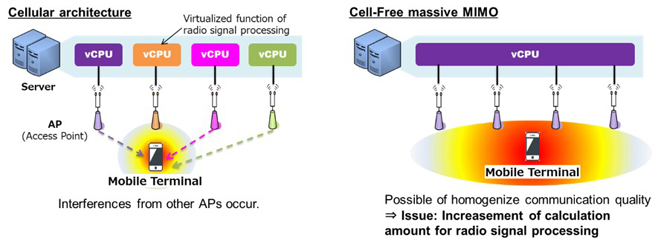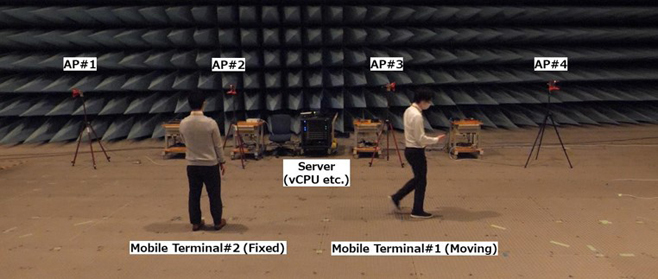 Print
Print
- Advanced Technology Laboratories
World first successful demonstration experiment of communication that supports both the provision of a wireless communication environment that responds to individual customer needs and power consumption reduction at base stations
~For Beyond the 5G/6G Era. Getting close to practical use of the next generation network architecture with AP clustering technology~
January 31, 2022
KDDI Research, Inc.
In January 11, 2022, KDDI Research, Inc., (Head office: Fujimino, Saitama; President and CEO: Hajime Nakamura;hereinafter referred to as “KDDI Research”) successfully concluded a demonstration experiment of Cell-Free massive MIMO (*1) for end to end (hereinafter referred to as “E2E”) communication with the adoption of AP Clustering technology, which selects coordinated base stations to establish communications for each individual customer. KDDI Research demonstrated for the first time that it is possible to reduce the calculation amount for radio signal processing while distributing a massive number of base station antennas. This can provide a wireless communication environment that responds to individual customer needs, and reduce power consumption by the base stations at the same time. (*2)

Figure 1: Network structure with AP Clustering technology
【Background】
After starting commercialization of 5G communication service on March 2020, various services have been launched using 5G properties such as the high-speed, low-latency. In the R&D field, initiatives for the next-generation communication system, Beyond 5G, where the 5G properties are increasingly more sophisticated, have begun.
A “cellular architecture” was adopted until 5G communication systems where the communication service area is determined on the basis of the location of the base station, which may not always provide the best communication quality due to the effects of interference between adjacent base stations depending on the customer position or time of use.
In order to resolve such issues, KDDI Research has been studying the development of Cell-Free massive MIMO technology, which can reduce the effects of interference for individual customers by distributing and coordinating a massive number of base station antennas (Figure 2). However, Cell-Free massive MIMO technology has the issue that a huge number of radio signal processing calculations to reduce interference between adjacent base stations.

Figure 2: Difference between cellular architecture and Cell-Free massive MIMO
【Achievements】
For the first time in the world, KDDI Research successfully concluded a demonstration experiment (hereinafter referred to as “the demonstration”) to establish IP level E2E communication between a server and devices by adopting AP Clustering technology into Cell-Free massive MIMO.
In the demonstration, KDDI Research established a wireless communication environment (Cell-Free massive MIMO environment) with servers for processing radio signals and 4 distributed base station antennas. The base station antennas cooperate with each other to provide data communication for mobile terminals by batch-processing the radio signals transmitted from and to each base station antenna (Figure 3). In the environment, a group of base station antennas (AP Clusters) (*3) are selected based on the location of each device (Figure 4). As an evaluation result, KDDI Research confirmed that the use of AP Clustering technology, which transmits radio signals to and from only using 3 base station antennas in AP Clusters, offers about the same throughput as that provided when all 4 base station antennas are used (Figure 5).
The demonstration clarified that high quality E2E communication can be established while maintaining homogenized communication quality, which is a characteristic of Cell-Free massive MIMO, even if AP Clustering technology is adopted and the number of APs decreases.

Figure 3: Demonstration environment

Figure 4: AP Clustering in demonstration environment

Figure 5: Demonstration results (Throughput)
By adopting AP Clustering technology into Cell-Free massive MIMO, the number of coordinated base station antennas per mobile terminals will be decreased. This achieves load reductions of the servers to process radio signals. According to a simulation by KDDI Research (*4), the calculation amount for radio signal processing by servers will decrease by one-fifth compared to when all base station antennas are used, when AP Clustering technology is applied to a one-kilometer square area. This reduction in the calculation amount is expected to help reduce power consumption at the base stations, because fewer servers are needed for small calculation amount.
【Future vision】
KDDI Research is engaged in realizing a “user-centric architecture (*5)” where individual customers can enjoy the required communication services in a variety of different environments.
The key achievements are technology demonstrations to resolve increasements of the calculation amount for radio signal processing and power consumptions at the base stations in an assumed environment actually employed by users. These are required when the user-centric architecture is adopted into a large communication environment, such as au Service Area. KDDI Research will continue to study for reducing the calculation amount and the power consumption with consideration of an advanced method of forming AP Clusters.
KDDI Research will integrate a radio and an optical based on this achievement and “radio over fiber technology”. The radio over fiber technology is an optical transmission technology of radio signals that can efficiently accommodate a massive number of base stations with fewer optical fibers. KDDI Research will promote the R&D of technologies for lower costs, lower the environmental burden, and rapid development of base stations based on the above integration.
This research result was obtained from the commissioned research (No.00401) by National Institute of Information and Communications Technology (NICT), Japan.
【Relevant results】
World first successful demonstration of wireless network deployment methodology for Beyond 5G (Released on October 7, 2021)
World’s First Demonstration of Radio over Fiber Technology for Mobile Networks with Large Capacity Transmission and Superior Installability (Released on December 7, 2020)
<KDDI Research’s Initiatives>
KDDI and KDDI Research formulated “KDDI Accelerate 5.0”, based on a concept for a next-generation society envisioned for 2030, and summarized how it can be accomplished in “Beyond 5G/6G Whitepaper” in terms of the “Future Image” and “Technologies” required to create an ecosystem that spurs innovation. To develop a new lifestyle, the two companies will continue to invest in R&D on seven different technologies and on an orchestration technology that links them together. The results presented in this study correspond to one of the seven technologies of the “Network.”
(*1)Base station coordination technology with multiple base station antennas to optimize the quality of radio signals for individual customers.
(*2)As of January 31, 2022, Investigated by KDDI Research
(*3)AP represents the “access point” and is synonymous with a base station antenna. It refers to a function to transmit radio signals from and to base stations. AP Cluster means a group of APs and is a range where radio signal processing is performed that includes interference reduction using Cell-Free massive MIMO.
(*4)Randomly placing 400 APs and 100 devices in a one-kilometer square area, KDDI Research ran computer simulations 20 times using and not using AP Clustering technology to calculate the average number of APs used by each mobile terminal. The calculation amounts are compared to use the simulation results, that is, the average number of APs in each mobile terminal.
(*5)The next generation network architecture is advocated by KDDI. The architecture can provide various mobile communication services to individual customers in Beyond 5G/6G era. To achieve the most suitable communication environment, the architecture provides communication services for each customer based on coordination of multiple base stations, and it is does not provided the services by a specific base station for each customer. The architecture has already been presented for the following documents:
・KDDI Beyond 5G/6G Whitepaper (First Edition released in March 2021, Second Edition released in October 2021)
・K. Yamazaki, T. Ohseki, Y. Amano, H. Shinbo, T. Murakami, and Y. Kishi, “Proposal for a user-centric RAN architecture towards beyond 5G,” 2021 ITU Kaleidoscope Academic Conference, pp. 1–7, Dec. 2021.
※The information contained in the articles is current at the time of publication.Products, service fees, service content and specifications, contact information, and other details are subject to change without notice.